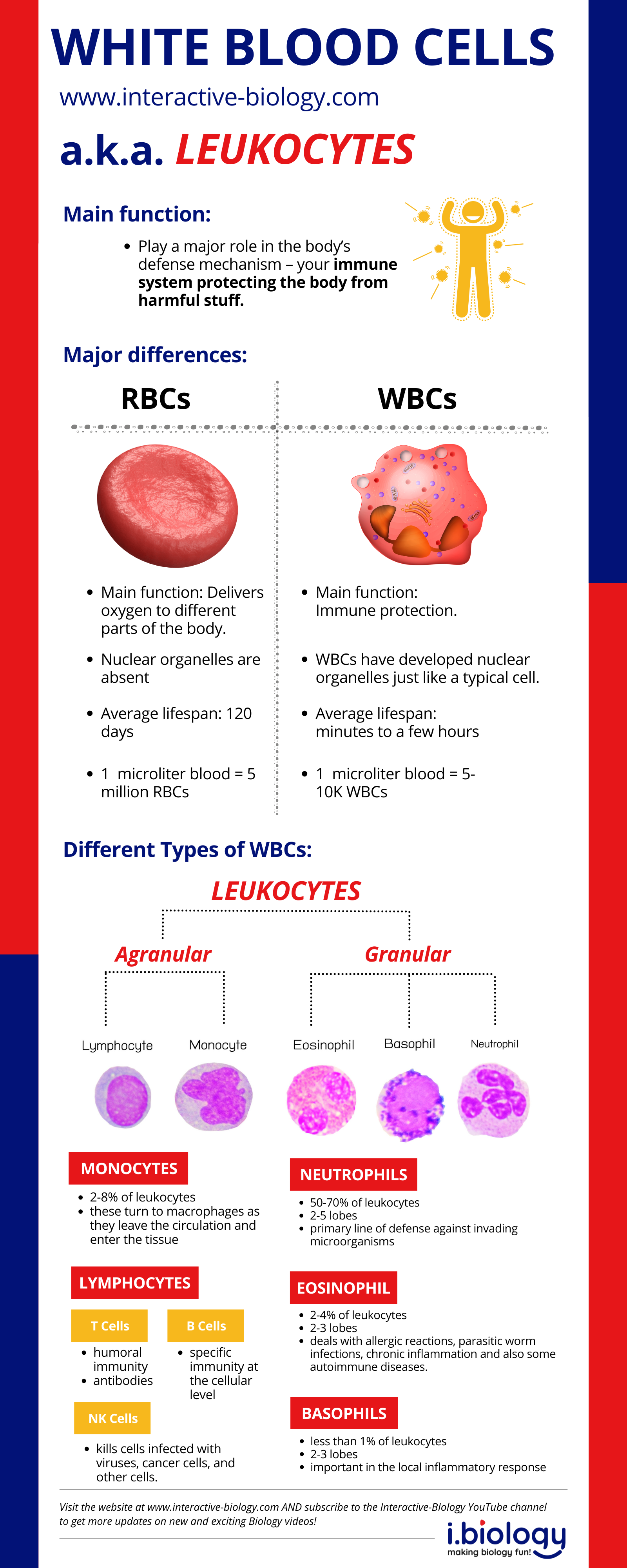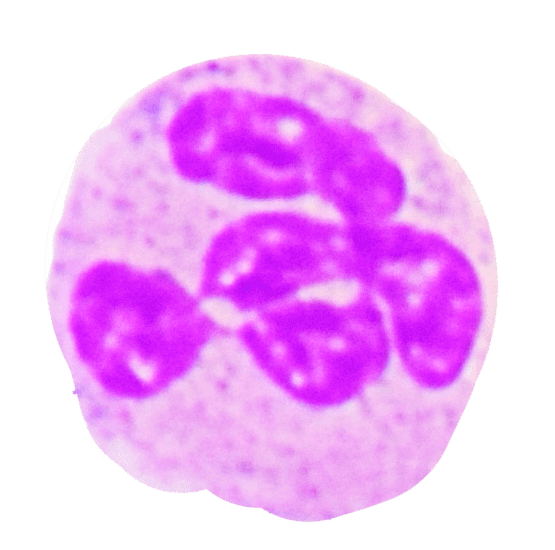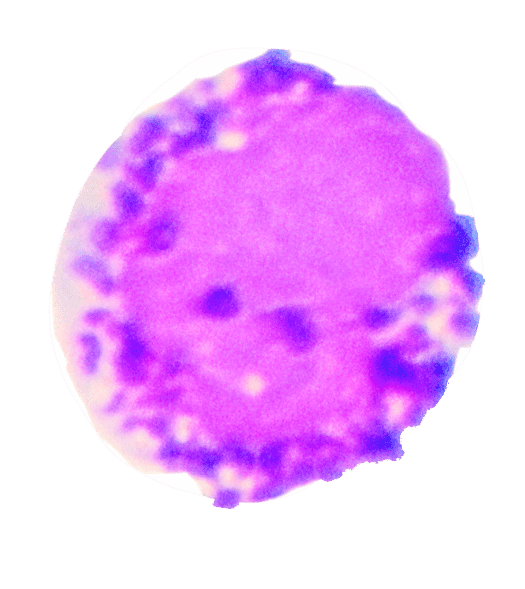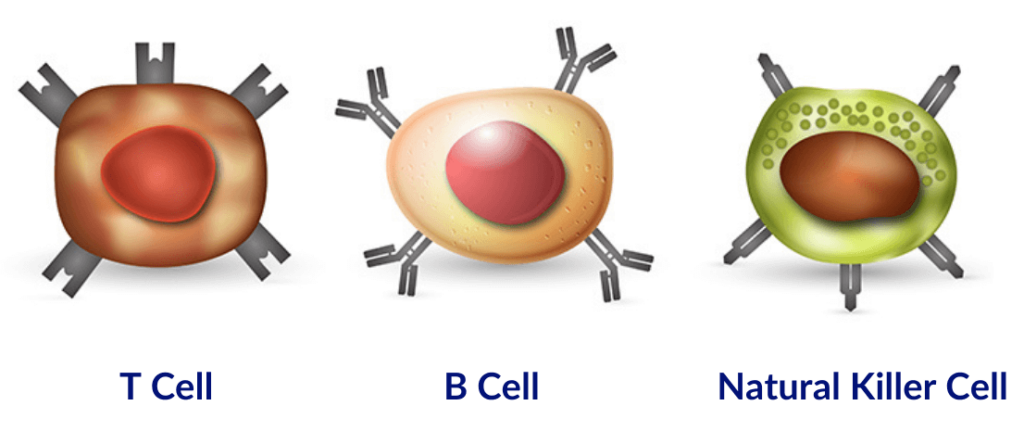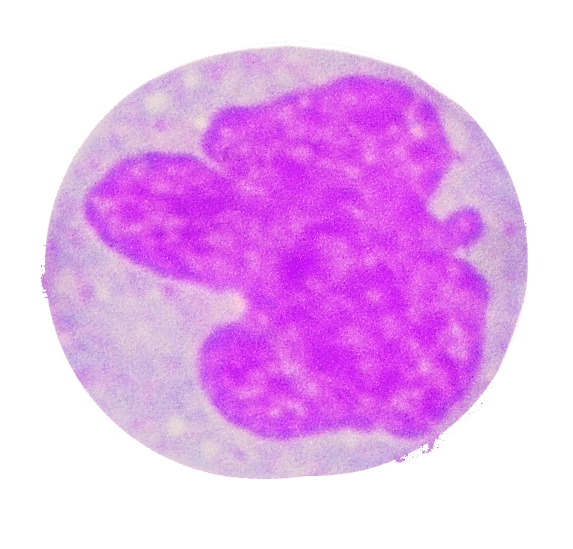White blood cells, a.k.a. Leukocytes are the second most common cell type in the blood. But what do we know about their structure and what exactly do they do?
Click here to leave a comment on YouTube
Topic Outline:
- Main Function of White Blood Cells
- Differences Between Red Blood Cells and White Blood Cells
- Different Types of WBCs / Leukocytes
Main Function of White Blood Cells
When something harmful enters the body, you want to have a way to get rid of it. Also, if something goes wrong with one of your body cells – let’s say a cell is produced with some jacked-up DNA, well, you want to get rid of that too.
White blood cells or leukocytes play a major role in the body’s defense mechanism – your immune system. You see, your immune system exists to protect the body from harmful stuff. And the White Blood cells – they’re a big part of those processes.
Differences Between Red Blood Cells and White Blood Cells
Now we’ve spent a good amount of time looking at red blood cells in previous videos. We even looked at how blood cells are made through the process of hemopoiesis.
Let’s talk about how white and red blood cells differ.
Structural Differences Between RBCs and WBCs
When we looked at how red blood cells were produced, we saw that at a certain point in the process, the differentiated cells got rid of organelles like the nucleus, endoplasmic reticulum, and others, so that they could be highly specialized for their functions of delivering oxygen.
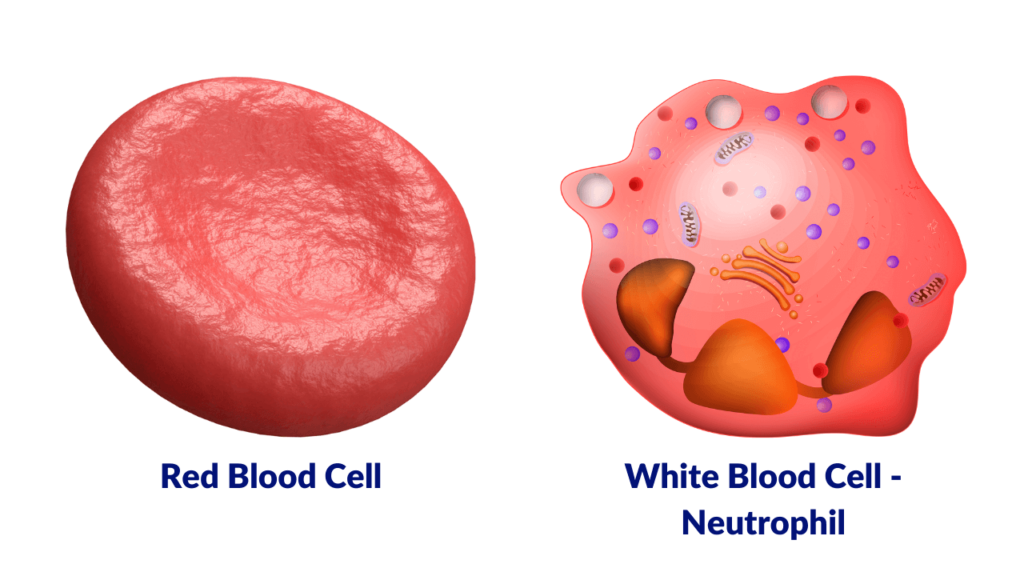
White blood cells, on the other hand, are different in that they are the one category of cells in the blood that are complete cells. By this, I mean they keep all of the organelles you’d see in a typical body cell.
Unlike red blood cells, they need DNA. They need mitochondria to generate energy, and they need to be able to create proteins like antibodies (and many others). So, you’ll see a nucleus. You’ll see things like the endoplasmic reticulum. But you’ll also see some other stuff.
Average Lifespan Differences Between RBCs and WBCs
Another difference between red and white blood cells is that white blood cells don’t have as long of a lifespan as red blood cells. The average red blood cell will typically last around 120 days, but some white blood cells can be around for just a few hours, and in some cases, even minutes depending on the type of infection they are trying to get rid of.
Amount of RBCs and WBCs in the Blood
One final difference between red and white blood cells is that there are way more red blood cells than white. While there can be around 5 million red blood cells in just one microliter of blood, there are typically around 5-10,000 White blood cells in that same amount of blood. Yeah, that’s a HUGE difference.
Diapedesis of WBCs
Now we have to talk about a very unique characteristic of white blood cells. Unlike erythrocytes – the red blood cells – leukocytes don’t spend all their time in blood vessels.
Yes, they travel along in the blood vessels as if scouting things out and it uses these blood vessels to get to a specific destination, but then they are able to leave the blood vessels and enter into the tissues directly via a process called diapedesis.
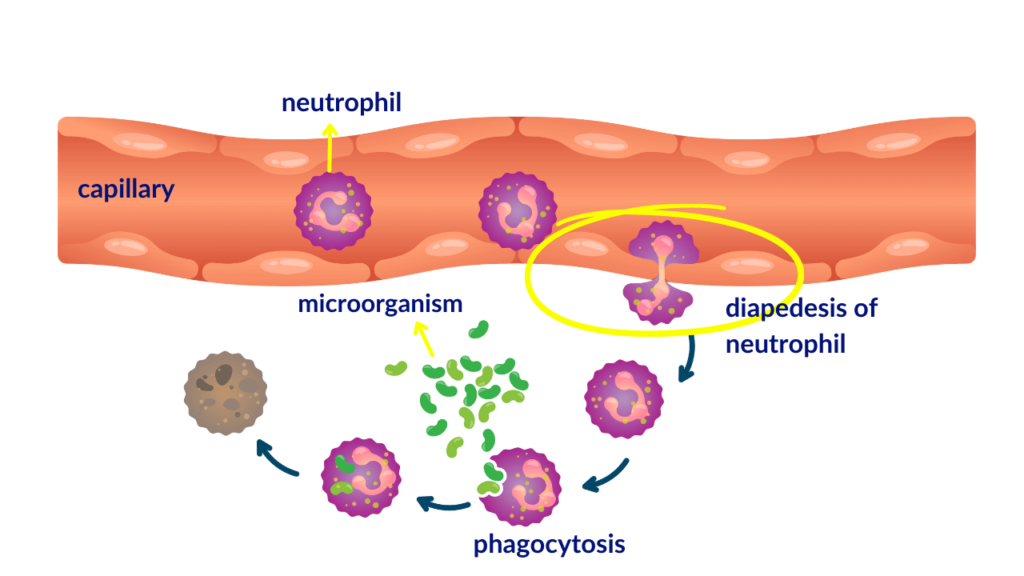
They will literally squeeze in between the cells of the blood vessel to get to where they need to go. It’s a pretty cool process.
Different Types of WBCs / Leukocytes
Leukocytes can be divided into two groups: granular leukocytes and agranular leukocytes. Now this distinction has to do with what early scientists observed under the microscope after staining them in different ways.
The three granular leukocytes are white blood cells that have granules inside of them. The granules are these little tiny containers – they are actually vesicles that have stuff inside of them that have specific functions. We’ll look at that in a little bit. The three granular leukocytes are the:
- Neutrophils
- Eosinophils, and
- Basophils.
The agranular leukocytes are the:
- Monocytes and the
- Lymphocytes.
And of course, they lack granules – hence the name agranular leukocytes.
Granular Leukocytes
Let’s dig into the granular leukocytes first. These cells are all produced in the red bone marrow and they live for a very short time. It can be hours or it can be days, which is very short if you compare that to the 120 days that red blood cells can last.
When you look at them, you’ll notice something very peculiar about their nuclei. They have these lobes. That’s another distinguishing characteristic.
Neutrophils
The most common of the three types of granular leukocytes are the neutrophils. They make up about 50 – 70 percent of the leukocytes.
They are called neutrophils because the granules show up clearly when you stain them with a stain that’s not acidic or basic. In other words, a neutral stain. That’s when you see them most clearly and they show up with a light lilac color.
And when looking at the nucleus of these neutrophils, you see that they can have anywhere from two to five lobes depending on the age of the cell. The older it gets, the more lobes you’re likely to see. Although keep in mind that they don’t stay around that long.
Neutrophils are part of the body’s primary line of defense against invading microorganisms – things like bacteria. When there are bacteria in your body, they often release certain chemicals – one example would be cytokines.
They are there circulating in the bloodstream and when they detect that chemical, they are attracted to the chemical. So they go to the site of infection to find the bacteria.
They will then – basically like eat up those bacteria bringing them into the cell. This process is called phagocytosis. Once the bacteria is in the cell, that’s when the granules go to work.
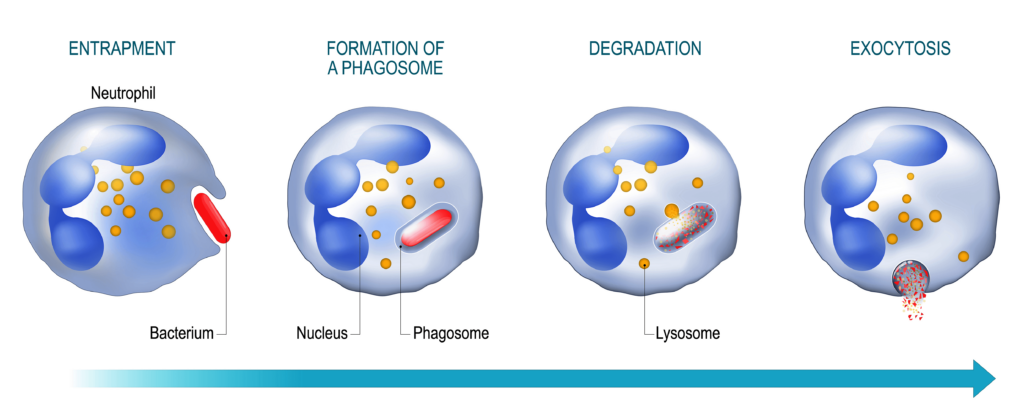
Inside the granules of the neutrophils, there are a number of substances. There’s an enzyme called lysozyme. Anytime you hear lyso or lysis, think of something that breaks stuff down. Hemolysis is breaking down blood cells.
In this case with the lysozyme, this enzyme helps to break down bacterial cell walls. But we also have some other stuff.
Hydrogen peroxide, and defensins. Basically, these substances and the others that are in the granules all work together to help break down those foreign invaders. You’ll see the granules combining with the ingested bacteria and digesting them. That’s how they do their work.
Eosinophils
Now let’s talk about Eosinophils. This makes up about 2 – 4 percent of the leukocyte population. They are called eosinophils because the granules show up best when they are stained with an acidic stain called eosin. Hence the name – eosinophils.
These cells also have lobes, but we’re talking like 2 or 3 lobes.
In their granules, you will find substances that are involved with dealing with things like allergic reactions, parasitic worm infections, chronic inflammation and also some autoimmune diseases.
So, when a person has eosinophilia – meaning there are higher than normal levels of eosinophils in the blood, that can be an indication that we’re dealing with one of those situations.
Basophils
The basophils make up about less than a percent of the leukocytes. You see their granules best when you use a basic stain.
Their granules are on the larger end and they show up dark blue when they are stained. These guys are very important in the local inflammatory response – they somewhat intensify that response. They have things like histamines and other substances that are involved in things like that.
So those were the granulocytes – the leukocytes with granules.
Now let’s talk about the agranular leukocytes.
Agranular Leukocytes (Lymphocytes and Monocytes)
First off – technically, these can still have granules, but they are smaller and less visible. When they were first described, they couldn’t see the tiny granules so they assumed they were agranular and the name has stuck.
There are two types of agranulocytes – the lymphocytes and the monocytes.
Lymphocytes
For the lymphocytes, we have 3 main types:
- The Natural killer or NK cells,
- The B cells or B Lymphocytes and,
- The T cells or T lymphocytes.
Natural Killer Cells
Let’s say a cell gets infected with a virus. There are cells that will display fragments of that virus on their surfaces.
When the natural killer cells detect those abnormal structures on the cells, they will actually kill the cells with the virus inside them. It does this for cells infected with viruses, cancer cells, and other cells that have weird proteins on their surfaces.
B and T cells (B and T lymphocytes)
These bad boys are part of what we call specific immunity. You see nonspecific immunity is more general. There’s inflammation or infection and the other leukocytes will fight against them in a more general way. They don’t care as much what it is. They just want to get rid of it because it’s bad.
With specific immunity, they are fighting against specific infections or antigens. The B cells will produce antibodies to fight against that specific disease. This form of specific immunity is called humoral immunity.
T cells are also involved in specific immunity but at the cellular level. They will physically attack the entire cell, whether that’s a foreign cell or a diseased cell. What’s cool about these B and T cells is that you also get memory cells.
Once there’s exposure to a specific illness these memory cells are produced so that if that same pathogen ever enters your system again, the response is much quicker towards that specific disease and that’s a beautiful thing.
A lot of vaccines are based on this concept. You build up antibodies against a specific disease, and if you encounter that disease, your body defenses are ready to attack.
Monocytes
Monocytes are larger cells and represent about 2 – 8 percent of the leukocytes. Once these monocytes leave the circulation and enter the tissue, they become macrophages that can take in bacteria and other antigenic material by phagocytosis – remember that pacman thing. Once they do that, they can help with getting rid of these substances – either by doing some damage themselves or by recruiting other cells to help in the process.
There’s a whole lot more we can say about white blood cells and I will. In the next video, we’ll dig into disorders that affect white blood cells.
Infographic
